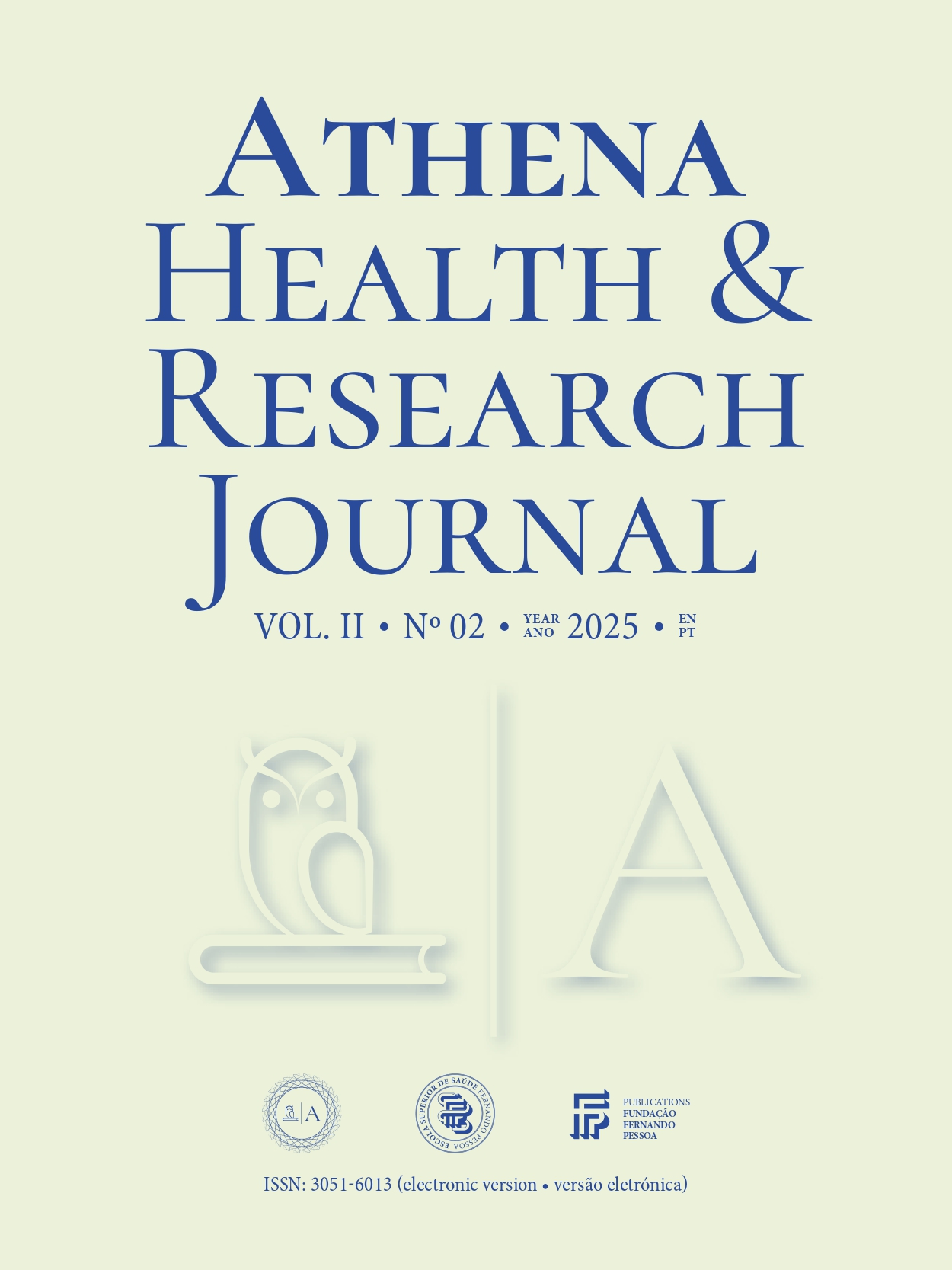Postoperative rehabilitation after lower limb amputation due to peripheral arterial disease
Scoping review protocol
DOI:
https://doi.org/10.62741/ahrj.v2i2.45Keywords:
Surgical Amputation, Peripheral Arterial Disease, Postoperative Care, RehabilitationAbstract
Introduction: After lower limb amputation surgery due to peripheral arterial disease, rehabilitation should be initiated early. Rehabilitation reduces complications and mortality, improves functional independence, mobility and prosthesis fitting. Despite the growing number of studies on people who have undergone amputation, no scoping review has yet mapped the evidence on rehabilitation interventions during the acute postoperative hospitalization period.
Objectives: To map which rehabilitation interventions are implemented and evaluated, aimed at people who have undergone lower limb amputation due to peripheral arterial disease, in the postoperative period.
Methodology: The scoping review will follow the Joanna Briggs Institute methodology. Several databases will be searched (MEDLINE (via PubMed), CINAHL (via EBSCO), Cochrane Database of Systematic Reviews, Scopus, PEDro, Web of Science, SciELO, SPORTDiscus with Full Text (via EBSCO), MedicLatina (via EBSCO)), and gray literature sources (Google Scholar, MedNar and RCAAP). Data extraction will use a tool developed based on the research objectives and eligibility criteria. Data synthesis will be presented narratively and in tables. The review will include studies with adults who underwent lower limb amputation due to peripheral arterial disease. Rehabilitation interventions implemented and evaluated by health professionals to promote functional independence, reduce hospital stay, and prevent complications will be considered. Studies with theoretical proposals, non-applied protocols, or targeting individuals already fitted with prostheses will be excluded.
Conclusion: This review will provide an overview of early postoperative rehabilitation for people with amputation due to peripheral arterial disease, supporting evidence-informed practice and identifying gaps for future research.References
Erzinger FL, Polimanti AC, Pinto DM, et al. Brazilian Society of Angiology and Vascular Surgery guidelines on peripheral artery dis-ease. J Vasc Bras. 2024;23. doi:10.1590/1677-5449.202300592
Bhargava A, Mahakalkar C, Kshirsagar S. Un-derstanding gangrene in the context of pe-ripheral vascular disease: prevalence, etiol-ogy, and considerations for amputation-level determination. Cureus. Published online November 19, 2023. doi:10.7759/cureus.49026
Longley SS, Dixon CJ, Tillman AP, Maroney SS. Bilateral below-knee amputations in Atherosclerotic limbs: a case report. Cureus. Published online October 11, 2024. doi:10.7759/cureus.71285
Neville RF. Management of peripheral arteri-al disease in the context of a multidiscipli-nary limb program. Front Cardiovasc Med. 2024;11. doi:10.3389/fcvm.2024.1368655
Rodrigues DF, Castanheira FSFM, de Carva-lho ALRF, Pinto CMCB. Nursing interven-tions to empower the family caregiver of person with lower limb amputation: scop-ing review. Rev Bras Enferm. 2024;77(1). doi:10.1590/0034-7167-2023-0264
Cain JJ, Ignaszewski D, Blymire C. Living well after amputation: lessons in innovation, peer support, and health policy; Published 2021. Accessed May 30, 2025. www.techortho.com
André A. A capacidade funcional e o perfil de autocuidado da pessoa com amputação do membro inferior. Dissertação de Mestrado. Published online 2016.
Fatima SZ. Life of an amputee: predictors of quality of life after lower limb amputation. . Wiener medizinische Wochenschrift. 2023;173:239-333.
Leinweber ME, Greistorfer E, Rettig J, et al. Quantification of the survival disadvantage associated with major amputation in pa-tients with peripheral arterial disease. J Clin Med. 2025;14(1). doi:10.3390/jcm14010104
O’Banion LA, Qumsiyeh Y, Matheny H, et al. Lower extremity amputation protocol: a pi-lot enhanced recovery pathway for vascular amputees. Journal of Vascular Surgery Cas-es, Innovations and Techniques. 2022;8(4):740-747. doi:10.1016/j.jvscit.2022.08.003
Thorud JC, Plemmons B, Buckley CJ, Shibuya N, Jupiter DC. Mortality after nontraumatic major amputation among patients with di-abetes and peripheral vascular disease: a sys-tematic review. The Journal of Foot and An-kle Surgery. 2016;55:591-599. doi:10.1053/j.jfas.2016.01.012
Guilcher SJT, Mayo AL, Swayze S, et al. Pat-terns of inpatient acute care and emergency department utilization within one year post-initial amputation among individuals with dysvascular major lower extremity amputation in Ontario, Canada: a popula-tion-based retrospective cohort study. PLoS One. 2024;19(7 July). doi:10.1371/journal.pone.0305381
Santos IM. Reabilitação pós-operatória da pessoa com amputação do membro inferior por etiologia vascular: que realidade? Mes-trado em Enfermagem de Reabilitação. Esco-la Superior de Enfermagem de Coimbra; 2019.
Ionac S, Rogers SK, Bondor CI, Bowling FL, Dragoi II, Ionac M. Lower extremity amputa-tion and peripheral revascularisation rates in Romania and their relationship with comorbidities and vascular care. J Clin Med. 2024;13(1). doi:10.3390/jcm13010052
Dekker R, Hristova Y V., Hijmans JM, Geertzen JHB. Pre-operative rehabilitation for dysvascular lower-limb amputee pa-tients: a focus group study involving medi-cal professionals. PLoS One. 2018;13(10). doi:10.1371/journal.pone.0204726
Ekkunagul T, MacLeod CS, Celnik A, et al. Processes and approaches to perioperative pain management in patients undergoing major lower extremity amputations sec-ondary to vascular disease: a multi-specialty modified Delphi consensus study protocol. BMJ Open. 2024;14(12):e090289. doi:10.1136/bmjopen-2024-090289
Clapp J, Firkins A, Owen R, Carty S. Improv-ing the provision of emotional support for patients following major lower limb ampu-tation. BMJ Open Qual. 2024;13(4). doi:10.1136/bmjoq-2024-002946
Berger AL, Nielsen AØ, Stie SB, Kristensen MT. Fatigue, fear of being mobilized and re-sidual limb pain limit independent basic mobility and physiotherapy for patients ear-ly after major dysvascular lower extremity amputation: a prospective cohort study. Ge-riatr Gerontol Int. 2024;24(5):470-476. doi:10.1111/ggi.14874
Pasquina PF, Miller M, Carvalho AJ, et al. Special considerations for multiple limb amputation. Curr Phys Med Rehabil Rep. 2014;2(4):273-289. doi:10.1007/s40141-014-0067-9
Aragão JA, Neves OMG, Aragão ICS, et al. Oc-currence of depression and assessment of functional capacity in patients with vascular diseases admitted to a vascular surgery Ser-vice. J Vasc Bras. 2023;22. doi:10.1590/1677-5449.202300822
Rodrigues D, Silva R, Castanheira S, Carvalho L, Pinto C. Needs of family caregivers of peo-ple with lower limb amputations: a scoping review. Behavioral Sciences. 2024;14(4). doi:10.3390/bs14040326
Marquez MG, Kowgier M, Journeay WS. Comorbidity and non-prosthetic inpatient rehabilitation outcomes after dysvascular lower extremity amputation. Canadian Prosthetics and Orthotics Journal. 2020;3(1). doi:10.33137/cpoj.v3i1.33916
Gailey R, Gaunaurd I, Raya M, et al. Effec-tiveness of an evidence-based amputee re-habilitation program: a pilot randomized controlled trial. Phys Ther. 2013;93(2):280-289. doi: 10.1093/ptj/pzaa008
Valente S, Lopes M, Sobral Sousa S, et al. Nursing interventions and 30-day hospital readmissions: scoping Review. Athena Health & Research Journal. 2025;1(3). doi:10.62741/ahrj.v1i3.25
Wong CK, Rosati J, Forbes K, Feng S, Donohue A, Beckley A. A scoping review of postoperative early rehabilitation programs after dysvascular-related amputations. Pros-thet Orthot Int. Published online October 21, 2024. doi:10.1097/pxr.0000000000000361
Peters MDJ, Marnie C, Tricco AC, et al. Up-dated methodological guidance for the conduct of scoping reviews. JBI Evid Synth. 2020;18(10):2119-2126. doi:10.11124/JBIES-20-00167
Tricco AC, Lillie E, Zarin W, et al. PRISMA ex-tension for scoping reviews (PRISMA-ScR): checklist and explanation. Ann Intern Med. 2018;169(7):467-473. doi:10.7326/M18-0850
Amin T, Mobbs RJ, Mostafa N, Sy LW, Choy WJ. Wearable devices for patient monitoring in the early postoperative period: a litera-ture review. Mhealth. 2021;7. doi:10.21037/mhealth-20-131
Page MJ, McKenzie JE, Bossuyt PM, et al. The PRISMA 2020 statement: an updated guide-line for reporting systematic reviews. Br Med J. 2021;372. doi:10.1136/bmj.n71
Munn Z, Aromataris E, Tufanaru C, et al. The development of software to support multi-ple systematic review types: the Joanna Briggs Institute system for the unified man-agement, assessment and review of infor-mation (JBI SUMARI). JBI Evid Implement. 2019;17(1). https://journals.lww.com/ijebh/fulltext/2019/03000/the_development_of_software_to_support_multiple.5.aspx
Downloads
Published
Versions
- 26-06-2025 (2)
- 26-06-2025 (1)
Issue
Section
License
Copyright of published papers is assigned to the Journal, but all content is licensed under the terms of Creative Commons Non-comercial 4.0 International License. Thus users are allowed to read, download, copy, distribute, print, search, or link to the full texts of the articles, or use them for any other lawful purpose, without asking prior permission from the publisher or the author. This is in accordance with the BOAI definition of open access.














